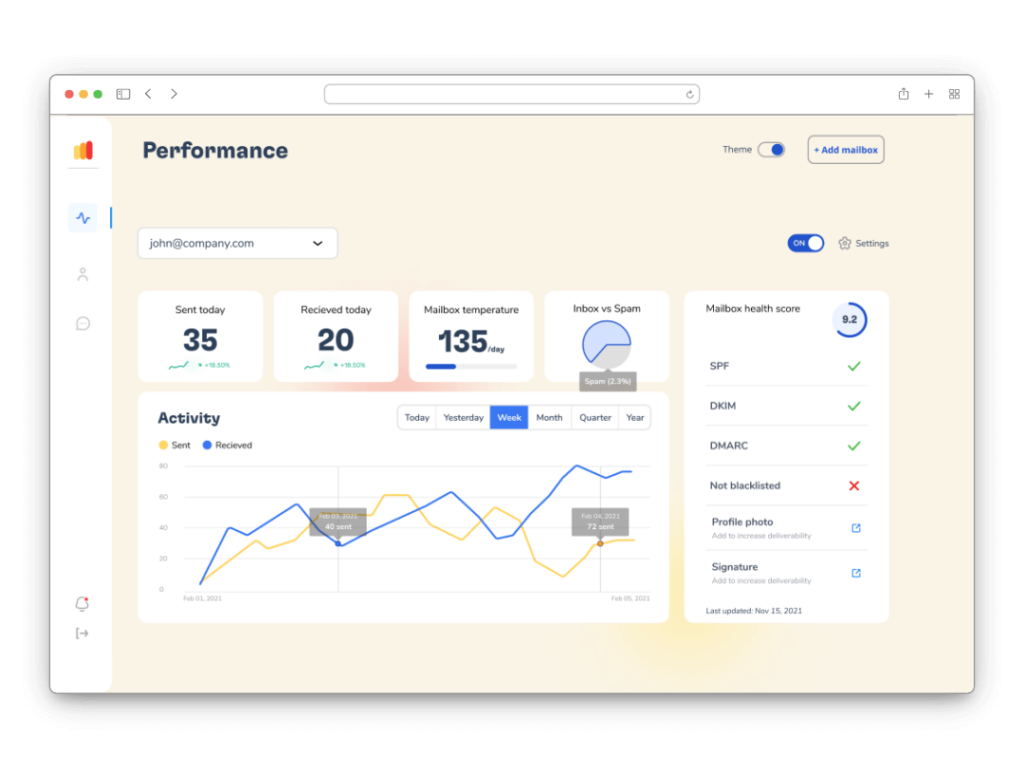Ensuring your message reaches its intended audience is more important than ever in a world when 306 billion emails are sent and received daily. Leading email marketing tool HubSpot has been front and first in enabling companies to properly interact with their customers.
Email deliverability is about making sure your emails reach the main inbox of your audience, not only about sending emails. Though HubSpot offers strong tools and features meant to maximize deliverability, like any great product it depends on appropriate configuration and strategy to get the greatest outcomes.
Let’s explore techniques that will enable you to maximize your email deliverability with HubSpot so that your well written messages are not only delivered but also noticed, opened, and acted upon.
Understanding email deliverability
Fundamentally, email deliverability is the capacity to send emails to recipients’ inboxes without getting blocked or sent to spam bins. This statistic is important because, should an email never be read by its intended recipient, it is useless. Deliverability is a complicated collection of standards used by email services to assess and filter incoming mail; it goes beyond simply having the correct email addresses.
Several key factors influence whether your emails make it to the inbox:
- Sender Reputation. Think of it as your email sending activities’ equivalent of credit score. Internet service providers (ISPs) evaluate your reputation using measures including the amount of emails you send, the frequency of those emails, the number of receivers who flag them as spam, and other sending patterns. Many times, emails with a bad sender reputation are marked as spam.
- Deliverability of your email is mostly dependent on its content quality. Sophisticated email algorithms are more likely to ignore poorly designed emails, those with dubious links, or those that seem spammy (with too much use of sales-oriented language like “Buy now!” or “Special offer!”).
- ISPs track recipient interaction with your emails. Deliverability is increased when you have high engagement rates (opens, replies, and forwards) which tell ISPs that your emails are important and wanted. On the other hand, a lot of ignored, deleted, or spammed emails can make it more difficult for you to get into inboxes going forward.
Common issues with email deliverability

HubSpot users frequently run across a number of issues that can have a big effect on how deliverable their email is. Resolving these typical problems and making sure your emails go to the right people start with knowing them.
1. IP Reputation Problems
Shared vs. Dedicated IP Addresses
If you utilize shared IP addresses, what other users doing with the same IP address can impact your email deliverability. Inadequate email practices by one user can damage the IP’s reputation and cause deliverability problems for other users. On the other hand, whilst a dedicated IP address allows you to manage your reputation, it needs more emails to be reliable.
Impact of Poor Practices on Shared IPs
All users on a shared IP may suffer if the IP is blacklisted for sending a lot of unwanted emails. This common fate makes selecting the appropriate email service configuration essential.
2. List Quality and Management
Importance of Clean Email Lists
The value of regularly cleaning your email list—removing inactive subscribers and invalid email addresses—helps to preserve a good sender reputation and enhance deliverability.
Consequences of Neglect
Deliverability is adversely impacted by high bounce rates and spam complaints brought on by neglecting to update email lists.
3. Email Content and Formatting
Triggering Spam Filters
ISP filters are more likely to intercept emails that seem spammy. This covers the use of too salesy subject lines, too promotional language, and pushy sales pitches.
Impact of Content Style
Complex HTML, too many links, or a high reliance on photos might also set off spam filters. Text and graphics should be balanced in emails, which should also be designed to be easily navigable.
4. Sender Authentication
Role of Authentication Protocols
Sender Policy Framework (SPF), DomainKeys Identified Mail (DKIM), and Domain-based Message Authentication, Reporting, and Conformance (DMARC) implementation is essential to confirming your sender identity and stopping email spoofing.
Common Setup Mistakes
These protocols’ incorrect setup can result in authentication failures, which ISPs can block or filter your emails.
5. User Engagement
Impact of Low Engagement
Internet service providers monitor how receivers respond to your emails. Your deliverability may suffer if low engagement rates indicate to ISPs that recipients are not interested in your emails.
Improving Engagement
Personalized content, audience segmentation for focused messages, and send time optimization based on user activity patterns are all ways to increase engagement.
Technical aspects affecting HubSpot deliverability
👉Integration issues with external platforms and CRMs can present significant challenges. Complex integrations may lead to synchronization problems, affecting how contact lists are updated and potentially leading to outdated or duplicated entries that harm deliverability.
👉Additionally, incorrect or incomplete data transfer from other systems to HubSpot can result in errors like incorrect email addresses, increasing bounce rates and negatively impacting your sender reputation.
👉 Furthermore, discrepancies in workflow between HubSpot and other tools can cause delays or failures in triggering necessary email communications, affecting the timeliness and relevance of the emails sent.
👉 There are also limitations in HubSpot’s algorithms or analytics that can mask deeper issues. While HubSpot’s analytics tools provide insights into metrics such as open rates and click-through rates, they may not capture issues like poor audience targeting or content mismatches. For instance, high open rates could obscure low conversion rates if the content does not effectively engage the audience.
👉 The algorithms that dictate email campaign optimizations and audience segmentation might be based on incomplete data sets or biased historical data, leading to suboptimal decision-making.
👉 Moreover, the granularity of reporting in HubSpot might not suffice for all marketing needs, particularly when detailed feedback is needed on why certain emails landed in spam folders or were blocked by ISPs.
Understanding and actively addressing these technical aspects can significantly enhance your HubSpot email deliverability, ensuring your marketing efforts effectively reach and engage your target audience.
Analyzing HubSpot's deliverability metrics
Any marketer trying to optimize the success of their email messages has to comprehend and evaluate the deliverability data offered by HubSpot. Though it’s important to understand how to evaluate these metrics and understand their limitations, they might offer insights into how well your emails are functioning.
Among the deliverability statistics offered by HubSpot are open, click-through, bounce, and spam complaint rates. Evaluation of the state of your email marketing campaigns depends critically on these metrics. To properly analyze these statistics, you must take them into account in relation to your overall marketing objectives. A high bounce rate can point to difficulties with list quality or out-of-date contact details, but a low open rate could point to problems with your subject lines or bad sender reputation.
Still up for contention, though, is how accurate these deliverability indications are. Email previews, for instance, or improper tracking when emails are viewed in some email clients that do not load tracking pixels, could cause the open rate to be exaggerated. Furthermore, if it counts several actions by the same user, the operating rate—which shows actions made on emails—can occasionally provide a distorted picture.
Use HubSpot’s stats as a guide rather than an exact measure to negotiate these obstacles. Adding outside tools or audience input to HubSpot’s data might provide you a more complete picture of how well your email campaign is doing. Better tactics and more successfully customized content can result from considering these metrics and challenging their correctness, which will eventually improve your email deliverability overall.

If you’re looking to solve problems with deliverability in HubSpot and enhance your overall email deliverability, consider using an email warm-up tool like Warmy.io.
Warmy.io is designed to improve your sender reputation gradually and systematically by sending emails from your account to its network of addresses, thereby ensuring your emails consistently reach inboxes. This process is crucial for anyone starting with a new email address or experiencing issues with deliverability due to low engagement or spam flagging.
Warmy.io offers a 7-day free trial, allowing you to use their service without any cost and test your email performance. This trial period is an excellent opportunity to see how effective Warmy.io can be in boosting your email metrics and sender reputation, with no obligation to continue if you’re not satisfied with the results.
Free Tools and Resources
Apart from the warm-up service, Warmy.io offers a number of free solutions made to meet your email deliverability requirements:
- By helping you configure these important email authentication techniques effectively, SPF and DMARC Record Generator lowers the likelihood that your communications will be flagged as spam.
- Free Email Deliverability Test. Find out how likely your emails will get in the inbox and gain useful information about possible issues.
- Check your email content and design for deliverability and engagement with the Email Template Checker.
Conclusion
To sum up, optimizing email deliverability with HubSpot involves a strategic, multifaceted approach that leverages the platform’s robust features and industry best practices. By focusing on key areas, you can significantly enhance how effectively your emails reach and engage your intended audience.
Additionally, by warming up your email domain and making sure recipient servers accept your emails, the utilization of services like Warmy.io can offer a big boost. Accepting these tactics will increase your deliverability rates and raise the general efficacy of your email marketing initiatives, which will eventually result in increased interaction and outcomes.
HubSpot’s potent capabilities can be fully used and the difficulties of email marketing can be managed by routinely examining deliverability metrics and remaining up to date on best practices. Recall that the objective is to make sure your well constructed communications are seen by your target, therefore promoting deep relationships and promoting company expansion.
📜 Related article:
FAQ
What is email deliverability?
Email deliverability is the capacity of your emails to get into the inboxes of the recipients without being rejected by email providers or classified as junk.
What are shared and dedicated IPs, and how do they affect my HubSpot deliverability?
Shared IPs involve multiple users sending emails from the same IP address, which can be beneficial for new senders but risky if other users engage in poor practices. Dedicated IPs, used only by your organization, give you more control over your sender reputation but require a higher volume of emails to maintain reliability.
What tools can help prevent my emails from landing in the spam folder?
Tools like Warmy.io help warm up your email domain, improving sender reputation over time. Additionally, using HubSpot’s built-in features to check for content issues and authenticate your emails can also prevent them from being marked as spam.
How often should I clean my email list in HubSpot?
It's important to clean lists often. Maintain a positive sender reputation by removing inactive subscribers, updating or deleting invalid email addresses, and segmenting your list according to demographic and engagement information.
What are the best practices for using HubSpot to send marketing emails?
Keeping a clean and segmented email list, regularly employing relevant and tailored content, making sure emails are mobile-friendly, testing emails before sending, and using analytics to improve tactics are among best practices.











